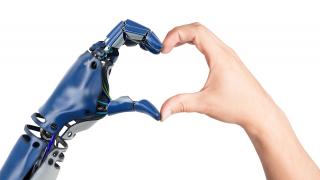
Automation - it’s a word that we tend to hear a lot these days, whether it’s on the news, or through articles in trade publications. With automation forming one of the key components of Industry 4.0, it’s hard to bury your head in the sand when it comes to the imminent changes surrounding manufacturing business practices.
Despite the common dystopian film trope that centres around the rebellion and uprising of robots, this is certainly not the biggest fear surrounding automation in its current form. Many companies - especially SMEs - have resisted automation due to fears surrounding job losses, believing that robots will make the employment of humans obsolete. This is true of no sector more than manufacturing, where a large percentage of jobs involve manual operations that are slowly being replaced by automated processes.
Are Automation Fears Founded?
Human input is still required to make business decisions and tackle customer-facing tasks such as sales and account management.
Although these fears have been stoked by numerous damning media reports, research has shown that automation will actually create significantly more jobs than it takes away. How is this possible? Well, firstly, it is not possible for robots to replace all jobs, as artificial intelligence is not universally developed. Robots are adept at completing manual labor and providing intelligence - however, human input is still required to make business decisions and tackle customer-facing tasks such as sales and account management.
Further to this, maintenance, installation and programming of robots will become crucial roles if automation is to succeed. In turn, this will lead to an influx of openings for professionals specialising in software development and data analysis, who are able to feed into and extract information from automated plant & machinery. This may lead to a shift in the ways in which engineering and manufacturing is conducted, with a focus on IT and programming instead of traditional skill sets; nonetheless, a working knowledge of engineering will still be required in order to successfully work within these professions.
With the skills gap only set to get worse before it gets better, the use of automation could be the solution to the current recruitment crisis facing the engineering industry. The results of programmes such as Tomorrow’s Engineers Week and the Year of Engineering - which are all geared towards encouraging younger generations to consider a career in engineering - will not be evident for the next decade, if at all. The new career opportunities presented by automation will no doubt be more appealing to our technology-orientated youth, meaning that automation’s influence may be exactly what our national industry needs to keep its head above water.
Robots vs Cobots:
Cobots are smart machines that are ultimately designed to assist humans and improve efficiency. The message given by the biggest cobot manufacturers is one of collaboration and cooperation; not replacement.
Even with the rise of automation, it’s very rare that a robot is given full autonomy over a specific task or process. At this point in technological evolution - and certainly for the foreseeable future - human assistance is still completely necessary to the success of manufacturing and production. More specifically, automation is currently driven by the use of collaborative robots, or ‘cobots’ - machines that work together with humans within the production sphere.
Despite being invented in the mid-1990s, cobots have only recently gained prominence within manufacturing. Unlike traditional robots, cobots are programmed to respect the safety of the humans they work with, instead of ruthlessly completing the tasks that they’ve been programmed to undertake. They can also be retrained as required, meaning that cobots can complete any tasks that pose a risk to safety, or plug gaps in production which could otherwise lead to a thinly-spread - and ultimately overwhelmed - human workforce.
Cobots are smart machines that are ultimately designed to assist humans and improve efficiency. The message given by the biggest cobot manufacturers is one of collaboration and cooperation; not replacement.

Job Shifts - Not Losses:
Change alone - no matter how uncomfortable - does not equate to human jeopardy or obsoletion.
Innovation is necessary for engineering & manufacturing to both survive and thrive. Automation is the natural progression of an industry with an abundance of manual tasks, so perhaps it is not surprising that the Fourth Industrial Revolution has centred itself around union between the digital, technological and physical realms.
As with any big industry changes, there is a resistance to embracing automation in fear of the impact it will have on those with bills to pay. Perhaps the speed of progression in technology has heightened these fears, or led many to believe that we are now at the point of complete takeover by industrial machines; however, this is not the case. If ever this is on the cards, it will be many, many years before the manufacturing industry achieves widespread full automation.
Instead of seeing automation as a threat, perhaps we should be focusing on the advantages it can bring to the table. Yes, there will be a shift in the nature of engineering & manufacturing professions, but change alone - no matter how uncomfortable - does not equate to human jeopardy or obsoletion.
Indeed, the current automation journey is one towards a safer, more efficient human workforce and is not something to be feared or resisted.
